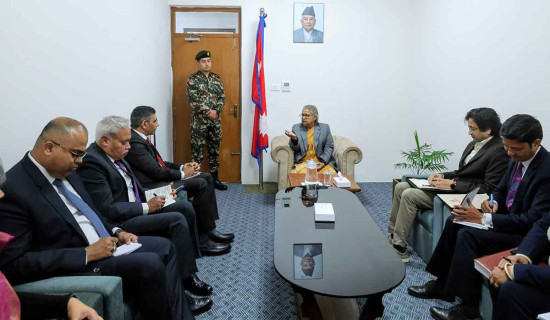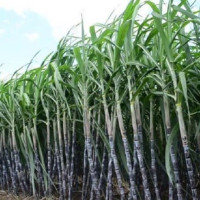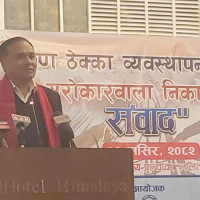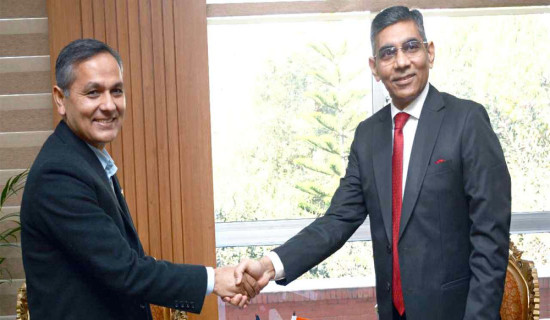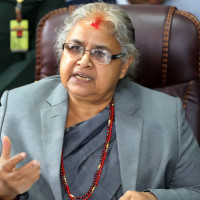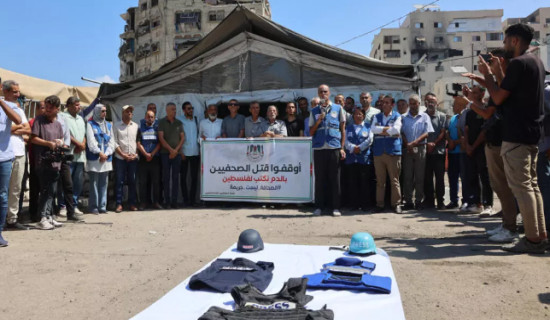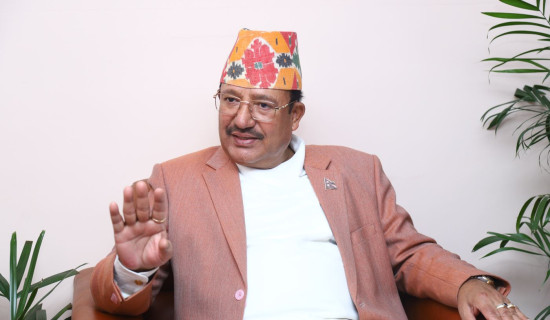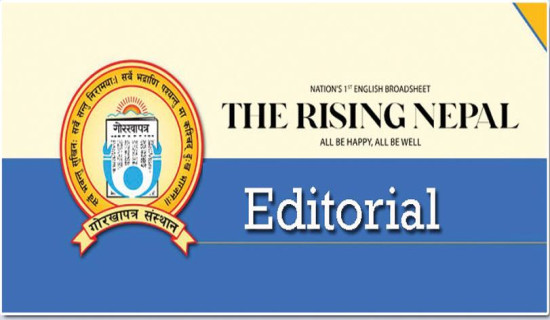- Tuesday, 9 December 2025
Energy roadmap achievable: Minister Khadka
The government has advanced ‘Energy Development Roadmap and Action Plan-2081’ to generate 28,500 MW of electricity in the next 10 years. Under the roadmap, 13,500 MW will be consumed internally and 15,000 MW will be exported. The government is dedicated to realising the roadmap by attracting investment from home and abroad. Recently, Minister for Energy, Water Resources and Irrigation Dipak Khadka visited India and held a meeting with his Indian counterpart on strengthening the energy cooperation between the two countries. In this backdrop, Laxman Kafle of The Rising Nepal talked to Minister Khadka about the plans of the government to realise the roadmap and prospect of energy development in Nepal. Excerpts:
You have just returned from a visit to India. What achievements were made in the field of water resources and energy during your visit?
This is my second visit to India after becoming a minister. During this visit, discussions have been held on issues including existing power transmission lines between Nepal and India, under-construction and proposed cross-border transmission lines, various Indian-invested hydropower projects and related transmission line projects, among others. So, the visit to India has been fruitful for cooperation in the development of Nepal's energy sector.
An agreement has been reached at the secretary-level meeting between the two countries on the modalities for the construction of a cross-border transmission line between Nepal and India. It has also been agreed that the construction of the transmission line on the Nepali side will be carried out in a joint venture modality with Nepal Electricity Authority holding 51 per cent and India's Power Grid 49 per cent, and for the transmission line on the Indian side, 51 per cent will be Power Grid's equity and 49 per cent will be Nepal Electricity Authority's equity.
An agreement has been reached to move forward with the Pancheshwor Multipurpose Project, which has been under discussion for almost 29 years, with the mutual benefit. The construction of the link canal from Tanakpur to the Nepal-India border has been completed, but it has been agreed to finalise the operational procedures for this soon and release water as per the Mahakali Treaty.
How will cooperation be maintained with neighbours for electricity generation and its marketing?
Our major electricity markets are India and Bangladesh. We don't have much export potential to China immediately. However, there is a possibility that a transmission line could be built there and exported in the future. During the rainy season, electricity consumption in India and Bangladesh is high, while Nepal produces more electricity and is forced to export it. Therefore, these countries are strategically important for Nepal.
Nepal exported up to 900 MW of electricity daily to India during the rainy season, and has also imported it in the dry season as per domestic demand. Nepal has already started selling 40 MW of electricity to Bangladesh using the Indian government's transmission, and we aim to sell about 5000 MW in the next 10 years. The Indian government is providing great support in electricity sales to Bangladesh. I would like to thank the Indian government for its support.
Therefore, our main focus is to bring FDI from neighbouring countries to increase electricity generation. The government alone cannot generate electricity, so Nepal's private sector can also collaborate with the private sector of India and other countries to bring in investment in hydropower.
Nepal and India have signed an agreement to trade 10,000 megawatts of electricity over the next 10 years. Electricity sales have also begun in Bangladesh. What is being done to implement the agreement in power trade?
We are saying that we will export 10,000 MW of electricity to India and 5,000 MW to Bangladesh within 10 years. An important agreement has been reached for the construction of the transmission line required for that. Nepal and India have been advancing different eight cross-border transmission line.
The first cross-border Dhalkebar-Muzaffarpur 400 kV transmission line, which is currently in operation, will be expanded to increase the import and export of electricity from 800 MW to 1000 MW. Similarly, the detailed project report of the 220 kV double circuit transmission line between Chameliya (Nepal) and Jauljibi (India) will be prepared by March 2025 and the Nepal Electricity Authority and the India Power Grid will complete the construction of the Nepal section of the transmission line by December 2027.
Similarly, to strengthen the electricity trade, the 400 kV Inaruwa (Duhabi)-Purnia (Bihar) and Dodhara (Lamki)-Bareli (Uttar Pradesh) cross-border transmission lines, 400 kV Nijgadh (Bara)-Motihari (Bihar) line, the Kohalpur-Lucknow (Uttar Pradesh) line have been extended. When the agreed transmission line is constructed, we can export 16,000-18000 MW of electricity to India and Bangladesh.
The government has recently introduced an energy development roadmap with a target of generating 28,500 MW of electricity by 2035. Is this ambitious plan feasible to achieve?
Definitely, it is feasible to increase electricity generation to 28,500 MW by 2035. The roadmap has been introduced with special plans and solution to the existing problems seen in the hydropower sector. The market for the sale of generated electricity is secured. With the assurance of market, investors, both domestic and foreign, will be interested to increase their investment. Of course, in the 113-year history of Nepal's hydropower development, the total power generation capacity has reached 3400 MW. At that time, there was no technology and the capacity of the private sector had not increased. At present time and scenario has changed. Now, technology has developed and studies of many hydropower projects have been completed. Now, except for large projects, a situation has been created where other projects can be completed within four to five years of the start of construction.

While preparing the modalities in the 81-point energy development roadmap, we have also looked for reasons for the delay in project construction yesterday. And we have also found a solution to that. Approximately Rs. 6,200 billion is required for the implementation of the roadmap. And it is challenging to raise it. However, the government of Nepal has set a goal to advance large projects from its own resources and to advance projects by involving the private sector with the participation of the general people. The government is preparing to advance about two dozen large projects such as Budhigandaki, Upper Arun, Uttarganga and Tamor, among others.
Similarly, there is a plan to increase investment in hydropower projects through banks and financial institutions. In addition, since the market has been ensured, we will also call for investment through foreign investors and development partners.
Developers are hesitant after the Supreme Court's order barring the construction of projects in national parks and conservation areas. How will the government move forward now?
The Supreme Court may have taken a decision after considering some laws. But we have to make laws considering the current needs of development. We, the government, are also conscious of protecting the environment and we believe that environmental balance should be maintained while carrying out construction work. We are in consultation in regard to whatever the Supreme Court has ordered. Parliamentarians and the government would prepare Acts and the Supreme Court gives verdict based on these Acts and laws. So, laws are made to allow construction. The developer does not need to worry much about this matter, the government will facilitate it.
Nepal still needs to import electricity in winter. How long will Nepal be self-sufficient in electricity?
It seems that it will take another one or two for us to become completely self-sufficient in electricity. Although, Nepal is increasing its electricity exports during the rainy season, it has been importing electricity to meet the domestic demand during the winter season. Last year, Nepal also became a net exporter. The government has put forward a plan to increase investment in reservoir projects with priority so as to become self-sufficient in the long term.
What changes need to be made to Nepal's energy policy?
The government is in the process of drafting and amending the Act related to energy and water resources. Alternative Energy Bill has been registered in the Parliament. Similarly, the Water Resources Bill is also under discussion. The private sector has demanded amendments to some points in the proposed Electricity Bill. The government is positive towards their demand.
The law we have made is for us and is private sector friendly and construction friendly. In the context of the government moving forward with a policy of developing energy by taking the private sector along, the private sector will not be treated differently. The government formulates laws in line with the times and moves forward by making policies that remove the doubts of the private sector.
Due to various reasons, the construction of transmission lines has not been completed on time, resulting in the wastage of electricity from many hydel projects. What initiatives are being taken to solve the problem of expansion of transmitter lines?
Now, there will be no problem in expansion of transmission line. Many private and government projects were wasting electricity due to the delay in the construction of transmission lines.
For the first time, the private sector has entered the construction of transmission lines for domestic power supply. The Tamor-Dhungesanghu 220 kV transmission line is to be built with investment from the private sector. Focusing on the expansion of transmission lines, the government is preparing a policy to involve the private sector. The policy formulation process has reached its final stage. Once the wheeling charge for transmission lines is decided, the private sector will be allowed to build transmission lines in all corridors. With the participation of the private sector, the construction of transmission lines, which are currently being invested solely by the Authority, will improve and the current problems will end.
What are the plans to extend the benefits of electricity generation to the underprivileged and poor group?
Definitely, the government is working to improve the living standards of the poor and marginalised through hydropower shares. The ministry has decided to provide shares of Rs. 200,000 to Rs. 500,000 to the poor and disadvantaged households without collateral and to participate in development.
Unless the poor and disadvantaged are made prosperous, the prosperous Nepal we have imagined cannot be built. It is the responsibility of all of us to make this class prosperous. According to statistics, about 20 per cent households are poor. After ensuring their share, the number of poor families will be reduced to zero in the next five years.
What incentives can be provided to general consumers to promote sustainable development by increasing domestic energy consumption?
The first priority of the government is to increase domestic consumption. So, we have to change the modality while charging tariffs. In the past, we had low electricity production. We used to charge high tariffs for those who consume high electricity and low for those who consume low electricity. Now, we have more electricity, we have to charge low for those who consume and purchase more electricity to attract them to increase consumption.
Similarly, we need to promote electric stoves to reduce import of liquefied petroleum gas and construct charging stations to promote electric vehicles as well The government has put forward a plan to provide electricity to all citizens within 1 to 1.5 years as around 98 per cent have access to electricity now. The government plans to provide electricity from alternative energy sources in places where the national transmission line cannot be extended immediately and gradually connect them to the national transmission line.
Finally, would you like to add something?
As hydropower is the foundation of the prosperity of the country, support from all, including the local level is required to promote this sector. Similarly, I want to request Nepali living in the country and abroad to invest in this sector. The government wants to move forward by ensuring a share in this sector for the poor and the disadvantaged community. I urge everyone to support and cooperate with the government in its endevour.



